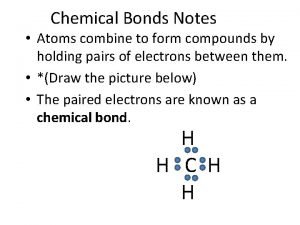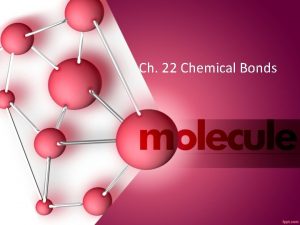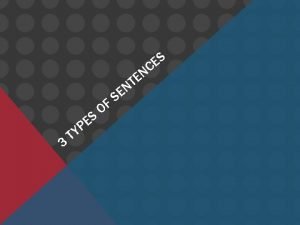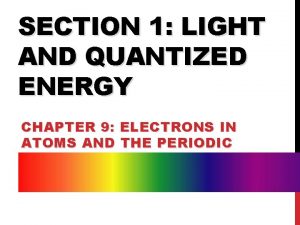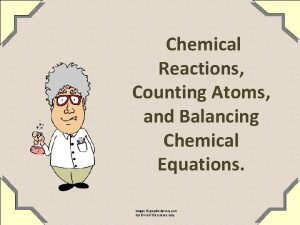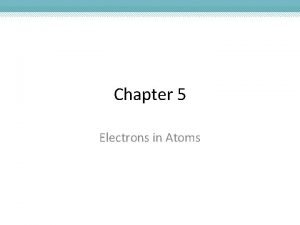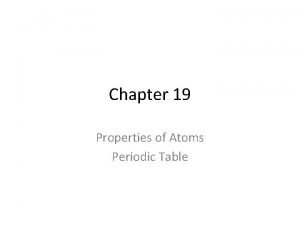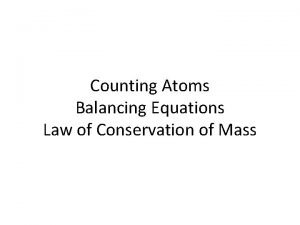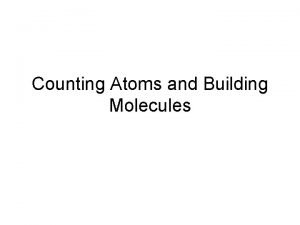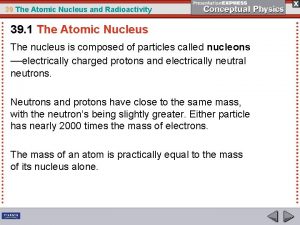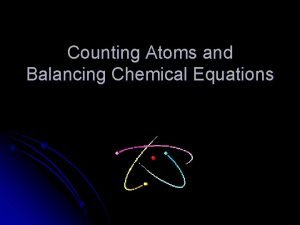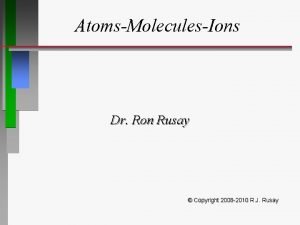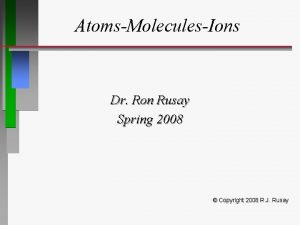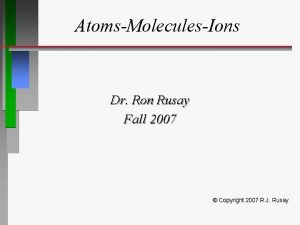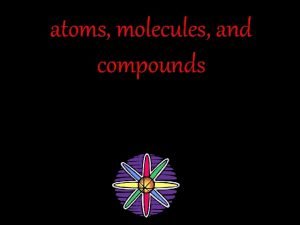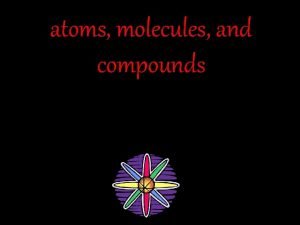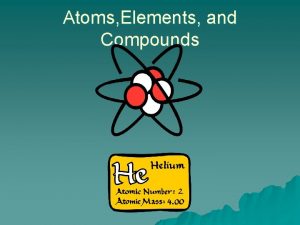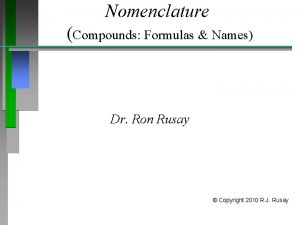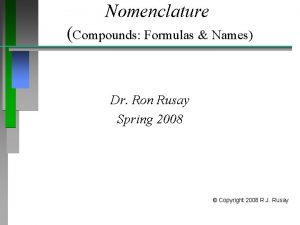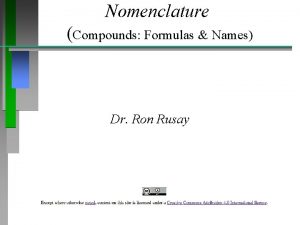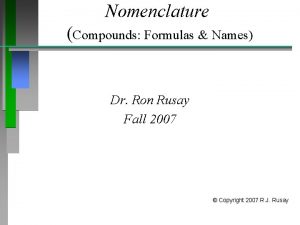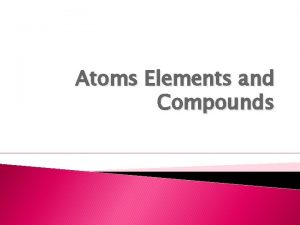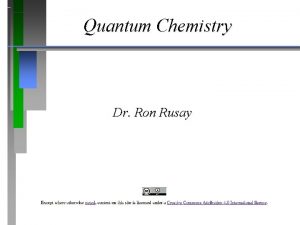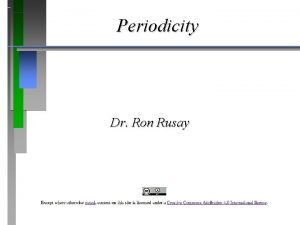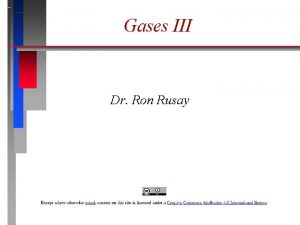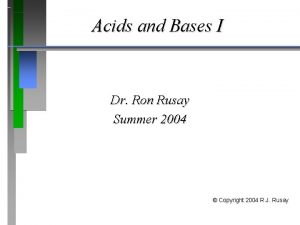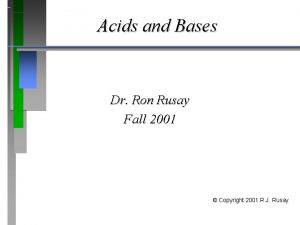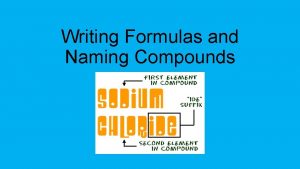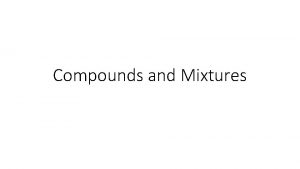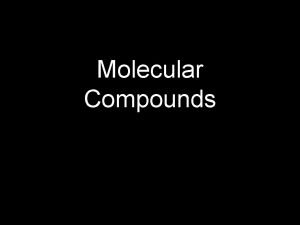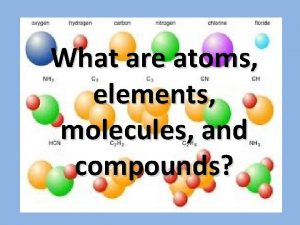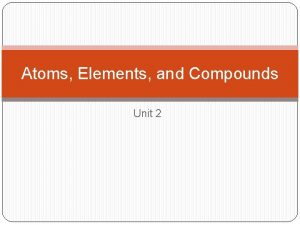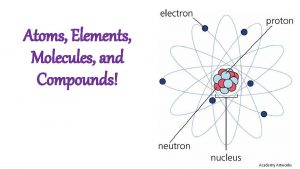AtomsMoleculesIons Dr Ron Rusay Atoms Compounds and the





































































- Slides: 69

Atoms-Molecules-Ions Dr. Ron Rusay

Atoms, Compounds, and the Periodic Table 2. 1 The Early History of Chemistry 2. 2 Fundamental Chemical Laws 2. 3 Dalton's Atomic Theory 2. 4 Early Experiments to Characterize the Atom 2. 5 The Modern View of Atomic Structure: An Introduction 2. 6 Molecules and Ions 2. 7 An Introduction to the Periodic Table 2. 8 Naming Simple Compounds

Modern History of the Atom ð ð 1909: Millikan determines charge and mass of e- 1913 -19: Rutherford & Bohr’s atom; The proton. http: //www. yrbe. edu. on. ca/~mdhs/science/chemistry/ch 2_2. htm ð 1926: Waves & Particles, Quantum Mechanics http: //chemed. chem. purdue. edu/genchem/history/schrodinger. html ð 1932: James Chadwick “discovers” the neutron http: //www. nmsi. ac. uk/on-line/electron/section 3/1932 a. html

CHEMISTRY of the Atom Ernest Rutherford (1871 -1937)

Modern History of the Atom 1897: J. J. Thomson “discovers” the electron: http: //www. nmsi. ac. uk/on-line/electron/section 2/ Photo © The Nobel Foundation http: //pl. nobel. se/laureates/physics-1906 -1 -bio. html

Milliken Oil Drop Experiment

How does an atom relate to nanotechnology? Consider Powers of 10 (10 x) http: //www. eamesoffice. com/powers_of_ten. html http: //www. powersof 10. com/ Earth = 12, 760, 000 meters wide (12. 76 x 10 6), 12. 76 million meters (megameters) Plant Cell = 0. 00001276 meters wide (12. 76 x 10 -6) (12. 76 millionths of a meter) (12, 760 nanometers!) Nano scale is regarded as < 1, 000 nanometers ~1/50 the diameter of a human hair (anything less than a micron (10 -6 m). Chemists typically think in views and images of < 1 nanometer (eg. bond lengths and atomic sizes).

~ 0. 1 nm Anders Jöns Ångström (1814 -1874) 1 Å = 10 picometers = 0. 1 nanometers = 10 -4 microns = 10 -8 centimeters • 1 nm = 10 Å • An atom vs. a nucleus ~10, 000 x larger Nucleus = 1/10, 000 of the atom

http: //science. kqed. org/quest/video/the-worlds-most-powerful-microscope/ Can we “see” and manipulate atoms using a microscope? Yes, using atomic force microscopy (AFM) and a variety of instruments such as Scanning Transmission Electron Microscopes. TEAM 0. 5: LBL’s Transmission Electron Aberration-corrected Microscope Resolution: • 1 nm = 10 Å +/- 0. 5 Å • An atom vs. a nucleus ~10, 000 x larger

Atomic/molecular structures atom-by-atom Building of a quantum “corral” with Fe atoms on Cu Xe atoms on Ni(110) STM images courtesy of Don Eigler, IBM, San Jose

Imaging: acetylene on Pd(111) at 28 K Molecular Image Tip cruising altitude ~700 pm Δz = 20 pm H C C H Why don’t we see the Pd atoms? Because the tip needs to be very close to image the Pd atoms and would knock the molecule away Surface atomic profile Tip cruising altitude ~500 pm Δz = 2 pm TIP pz H + O p orbital Calculated image (Philippe Sautet) If the tip was made as big as an airplane, it would be flying at 1 cm from the surface and waving up an down by 1 micrometer The STM image is a map of the pi-orbital of distorted acetylene M. Salmeron (LBL) 1 cm (± 1 μm)

Excitation of frustrated rotational modes in acetylene molecules on Pd(111) at T = 30 K Tip e- ((( ) ( ))) M. Salmeron (LBL)

CHEMISTRY of the Atom FUNDAMENTAL PARTICLES: Mass Charge Nucleus: ð PROTON 1 amu +1 Symbol H+, H, p • 1. 67 x 10 -27 kg ð NEUTRON 1 amu 0 n • 1. 67 x 10 -27 kg _____________________ ð ELECTRON very small -1 e • 2000 x smaller than a proton or neutron The particle is said to “hold” or “bond” atoms together in molecules.

Periodic Table • Mendeleev’s Table 1868 -1871 Mural at St. Petersburg University, Russia


Periodic Table Los Alamos National Lab

QUESTION The element found in the 6 A family (or group 16) and period four can be toxic, a micronutrient, and found in compounds in dandruff shampoos. What is the symbol for that element? A. B. C. D. Sb As Se Te

Answer The element found in the 6 A family (or group 16) and period four can be toxic, a micronutrient, and found in compounds in dandruff shampoos. What is the symbol for that element? A. B. C. D. Sb As Se Te

http: //chemconnections. org/general/movies/leher-elements. swf Chemical Symbols & Historical Names What is the symbol for gold and what was its original name?

QUESTION

Answer


QUESTION Of the following which would not be considered a metalloid? A. B. C. D. E. Ge Sb Te Se As

Answer Of the following which would not be considered a metalloid? A. B. C. D. E. Ge Sb Te Se As

Periodic Table ð Elements are classified by: properties & atomic number metals, non-metals, metalloids ð Groups or Families (vertical) 1 A = alkali metals 2 A = alkaline earth metals 6 A (16) = chalcogens 7 A (17) = halogens 8 A (18) = noble gases ð Periods (horizontal) numbers 1 -7

QUESTION Select the correct statement relative to the modern periodic table. A) Tin is a transition element. B) Lead is a nonmetal. C) Antimony is a metalloid. D) Elements are arranged in order of increasing atomic mass. E) Sulfur is a halogen.

Answer Select the correct statement relative to the modern periodic table. A) Tin is a transition element. B) Lead is a nonmetal. C) Antimony is a metalloid. D) Elements are arranged in order of increasing atomic mass. E) Sulfur is a halogen.

Group 1 and Group 2 Metals

Using the Periodic Table

Atoms, Molecules & Ions ð Atoms (neutral electrostatic charge: # protons • • = # electrons ) # Protons = Atomic Number Atomic Mass = # Protons + # of Neutrons • Isotope: same atomic number but different atomic mass (different # of neutrons)

QUESTION

Answer

Atoms, Molecules & Ions • Isotopes vary in their relative natural abundance. • Periodic Table’s atomic mass is a weighted average of all isotopic masses • The mass of sodium, Na, element #11 is listed as 22. 99 amu. Which isotope is naturally present in the larger amount: the isotope with 12 neutrons or with 13 neutrons? (There is a small percentage of the isotope with 11 neutrons. )

QUESTION Two stable isotopes of an element have isotopic masses of 10. 0129 amu and 11. 0093 amu. The atomic mass is 10. 81. Which isotope is more abundant? A) There is insufficient information to answer the question. B) There are equal amounts of each isotope. C) The isotope with a mass of 10. 0129 amu is more abundant. D) The isotope with a mass of 11. 0093 amu is more abundant.

Answer Two stable isotopes of an element have isotopic masses of 10. 0129 amu and 11. 0093 amu. The atomic mass is 10. 81. Which isotope is more abundant? A) There is insufficient information to answer the question. B) There are equal amounts of each isotope. C) The isotope with a mass of 10. 0129 amu is more abundant. D) The isotope with a mass of 11. 0093 amu is more abundant.

Atoms, Molecules & Ions ð ð Atomic Mass of Carbon: What is the “weighted” atomic mass? 12. 00000 x 98. 98/100 + 13. 00335 x 1. 011 = 11. 8776 + 0. 13146 = 12. 0090 12. 01

QUESTION The two major isotopes of bromine are 79 Br and 81 Br. Assume that the masses of the 79 Br and 81 Br isotopes are 79. 00 and 81. 00 amu, respectively. The weighted average atomic mass of bromine is 79. 90 amu. What are the relative % abundances of each isotope? • % Abundance of 79 Br 79. 0% % Abundance of 81 Br 21. 0% • 19. 0% 81. 0% • 35. 1% 64. 9% • 55. 0% 45. 0%

Answer The two major isotopes of bromine are 79 Br and 81 Br. Assume that the masses of the 79 Br and 81 Br isotopes are 79. 00 and 81. 00 amu, respectively. The weighted average atomic mass of bromine is 79. 90 amu. What are the relative % abundances of each isotope? • % Abundance of 79 Br 79. 0% % Abundance of 81 Br 21. 0% • 19. 0% 81. 0% • 35. 1% 64. 9% • 55. 0% 45. 0%

Atoms, Molecules and Ions • • • Atomic Number = 6 (atom’s identity) Carbon Atomic Mass = 13 (isotope 13) 6 protons; # neutrons = 13 - 6 neutral atom has 6 electrons

QUESTION

None of the isotopes has an exact mass of 12. 011. Answer

Atomic Symbols Mass number 39 K 19 Element Symbol Atomic number Also written as 39 K

Atoms, Molecules and Ions • • • Atomic Number = 12 (atom’s identity) Atomic Mass = 24 12 protons; # neutrons = 24 - 12 neutral atom has 12 electrons Ion contains 10 electrons: symbol? • 12 p+ + 10 e- = +2

Atoms, Molecules and Ions • • • Atomic Number = 17 (atom’s identity) Atomic Mass = ? # protons = ? ; # neutrons = ? neutral atom has ? electrons Ion contains 18 electrons: symbol? • 17 p+ + 18 e- = -1

Ions ð Cation: ð Anion: ð Ionic A positive ion ð Mg 2+, NH 4+ A negative ion ð Cl , SO 42 Bonding: Force of attraction between oppositely charged ions.

QUESTION Calcium plays several critical roles in the functioning of human cells. However, this form of calcium is the ion made with 20 protons and 18 electrons. Therefore the ion would be… A. B. C. D. positive and called an anion. positive and called a cation. negative and called an anion. negative and called a cation.

Answer Calcium plays several critical roles in the functioning of human cells. However, this form of calcium is the ion made with 20 protons and 18 electrons. Therefore the ion would be… A. B. C. D. positive and called an anion. positive and called a cation. negative and called an anion. negative and called a cation. An atom of calcium (20 protons = 20+) which has lost two electrons (now with 18–). The ion would have a +2 charge. Positive ions are called cations.

QUESTION Of the following, which would NOT qualify as an isotope of 35 Cl? A. B. C. D. 36 Cl 35 Cl– 37 Cl

Answer Of the following, which would NOT qualify as an isotope of 35 Cl? A. B. C. D. 36 Cl 35 Cl– 37 Cl B. has the same number of neutrons as the atom in the question, therefore it does not fit the criteria for isotopes (i. e. different number of neutrons with the same proton number). Isotopes can be ions as well as neutral atoms. 37 Cl– and 37 Cl are also not a pair of isotopes.

Worksheet: Atoms I (Lab Manual)

QUESTION Which of these species has the highest number of electrons? A) 20 Ca B) 19 K+ C) 16 S 2− D) 15 P 3−

Answer Which of these species has the highest number of electrons? A) 20 Ca B) 19 K+ C) 16 S 2− D) 15 P 3−

QUESTION The ion 45 Sc 3+ has A) 24 electrons, 21 protons and 24 neutrons B) 18 electrons, 21 protons and 24 neutrons C) 24 electrons, 24 protons and 21 neutrons D) 18 electrons, 24 protons and 21 neutrons

Answer The ion 45 Sc 3+ has A) 24 electrons, 21 protons and 24 neutrons B) 18 electrons, 21 protons and 24 neutrons C) 24 electrons, 24 protons and 21 neutrons D) 18 electrons, 24 protons and 21 neutrons


Molecules ð Neutrally Charged ð Eg. Salt: Na. Cl -> 1 Na+ and 1 Cl ð What is the proportion of ions for a compound formed from Mg ion and chlorine? ð Mg 2+ and Cl ð 1 Mg 2+ combines with 2 Cl Mg. Cl 2

QUESTION Predict the formula for the binary ionic compound formed by aluminum and oxygen. A) Al 2 O 3 B) Al 3 O 2 C) Al 2 O D) Al. O 2

ANSWER Predict the formula for the binary ionic compound formed by aluminum and oxygen. A) Al 2 O 3 B) Al 3 O 2 C) Al 2 O D) Al. O 2

Polyatomic Ions http: //chemconnections. org/general/chem 120/polyatomics. html

QUESTION Which formula containing polyatomic ions is correct? A) Mg. NO 3 B) NH 4 CO 3 C) Na(PO 4)3 D) Al 2(SO 4)3

ANSWER Which formula containing polyatomic ions is correct? A) Mg. NO 3 B) NH 4 CO 3 C) Na(PO 4)3 D) Al 2(SO 4)3


Ionic vs. Covalent

Ionic vs. Covalent Metals generally combine with non- metals to form ionic compounds. Electrons are “lost” by the metal and “gained” by the non-metal following the octet rule. ð Non-metals generally combine with nonmetals to form covalent compounds where electrons are “shared”. Each pair of electrons ia a covalent bond. Eg. H 2 O ð Polyatomic ions have both covalent and ionic properties. Eg. hydroxide, OHð

QUESTION

Answer

Chemical Formulas ð Molecular Formula: Elements’ Symbols = atoms Subscripts = relative numbers of atoms ð How many atoms of each element are in the following componds? Mg. Cl 2 CCl 4 Na. OH (NH 4 )2 CO 3 C 20 H 26 N 2 O (Ibogaine, not ionic)

QUESTION

Answer
 Rusay
Rusay Substance
Substance Chemistry in biology section 2 chemical reactions
Chemistry in biology section 2 chemical reactions Chemistry in biology section 2 chemical reactions
Chemistry in biology section 2 chemical reactions Chapter 6 section 1 atoms elements and compounds
Chapter 6 section 1 atoms elements and compounds At stp which substance is the best conductor of electricity
At stp which substance is the best conductor of electricity Venn diagram ionic and covalent bonds
Venn diagram ionic and covalent bonds Atoms combine to form compounds
Atoms combine to form compounds In covalent compounds atoms become chemically stable
In covalent compounds atoms become chemically stable Hát kết hợp bộ gõ cơ thể
Hát kết hợp bộ gõ cơ thể Ng-html
Ng-html Bổ thể
Bổ thể Tỉ lệ cơ thể trẻ em
Tỉ lệ cơ thể trẻ em Chó sói
Chó sói Tư thế worm breton
Tư thế worm breton Chúa sống lại
Chúa sống lại Môn thể thao bắt đầu bằng chữ f
Môn thể thao bắt đầu bằng chữ f Thế nào là hệ số cao nhất
Thế nào là hệ số cao nhất Các châu lục và đại dương trên thế giới
Các châu lục và đại dương trên thế giới Công thức tính thế năng
Công thức tính thế năng Trời xanh đây là của chúng ta thể thơ
Trời xanh đây là của chúng ta thể thơ Mật thư anh em như thể tay chân
Mật thư anh em như thể tay chân Phép trừ bù
Phép trừ bù độ dài liên kết
độ dài liên kết Các châu lục và đại dương trên thế giới
Các châu lục và đại dương trên thế giới Thể thơ truyền thống
Thể thơ truyền thống Quá trình desamine hóa có thể tạo ra
Quá trình desamine hóa có thể tạo ra Một số thể thơ truyền thống
Một số thể thơ truyền thống Cái miệng bé xinh thế chỉ nói điều hay thôi
Cái miệng bé xinh thế chỉ nói điều hay thôi Vẽ hình chiếu vuông góc của vật thể sau
Vẽ hình chiếu vuông góc của vật thể sau Nguyên nhân của sự mỏi cơ sinh 8
Nguyên nhân của sự mỏi cơ sinh 8 đặc điểm cơ thể của người tối cổ
đặc điểm cơ thể của người tối cổ V cc
V cc Vẽ hình chiếu đứng bằng cạnh của vật thể
Vẽ hình chiếu đứng bằng cạnh của vật thể Tia chieu sa te
Tia chieu sa te Thẻ vin
Thẻ vin đại từ thay thế
đại từ thay thế điện thế nghỉ
điện thế nghỉ Tư thế ngồi viết
Tư thế ngồi viết Diễn thế sinh thái là
Diễn thế sinh thái là Dot
Dot Các số nguyên tố
Các số nguyên tố Tư thế ngồi viết
Tư thế ngồi viết Lời thề hippocrates
Lời thề hippocrates Thiếu nhi thế giới liên hoan
Thiếu nhi thế giới liên hoan ưu thế lai là gì
ưu thế lai là gì Khi nào hổ mẹ dạy hổ con săn mồi
Khi nào hổ mẹ dạy hổ con săn mồi Khi nào hổ con có thể sống độc lập
Khi nào hổ con có thể sống độc lập Hệ hô hấp
Hệ hô hấp Từ ngữ thể hiện lòng nhân hậu
Từ ngữ thể hiện lòng nhân hậu Thế nào là mạng điện lắp đặt kiểu nổi
Thế nào là mạng điện lắp đặt kiểu nổi Megan and ron ate too much and felt sick
Megan and ron ate too much and felt sick Relationship between atoms and molecules
Relationship between atoms and molecules Electrons in atoms section 1 light and quantized energy
Electrons in atoms section 1 light and quantized energy Counting atoms and balancing equations
Counting atoms and balancing equations Electrons in atoms section 1 light and quantized energy
Electrons in atoms section 1 light and quantized energy Properties of atoms and the periodic table
Properties of atoms and the periodic table Lowest allowable energy state of an atom
Lowest allowable energy state of an atom Mit center for bits and atoms
Mit center for bits and atoms Electrons in atoms section 2 quantum theory and the atom
Electrons in atoms section 2 quantum theory and the atom Adding atoms
Adding atoms How can you count atoms and molecules
How can you count atoms and molecules Atoms and radioactivity
Atoms and radioactivity Counting atoms and balancing equations worksheet
Counting atoms and balancing equations worksheet Atoms and their isotopes pogil
Atoms and their isotopes pogil Ion chapter 11
Ion chapter 11 Atoms molecules and ions
Atoms molecules and ions Atoms molecules and ions
Atoms molecules and ions Atoms molecules and ions
Atoms molecules and ions Atoms ions and molecules
Atoms ions and molecules







